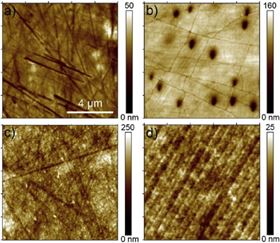 Surface topography of submerged soft contact lenses used in this study. a) Lotrafilcon B, b) Balafilcon A, c) Senofilcon A, d) Comfilcon A.
Surface topography of submerged soft contact lenses used in this study. a) Lotrafilcon B, b) Balafilcon A, c) Senofilcon A, d) Comfilcon A.We present comparative micromechanical characterization of several commercial soft silicone hydrogel contact lenses, which allows for the examination of spatial distribution of different regions with local mechanical properties within the lens under practical wet conditions. We employ elastic contact mechanic model and corresponding analysis of force–distance curves collected with high-resolution atomic force microscopy measurements performed within elastic deformation limits. The measurements were performed on the lens cross section to map the micromechanical properties distribution within the sub-surface regions and bulk material of the different lens. In addition, we have studied topography and mechanical properties of the lens surfaces, which come into direct contact with the surface of the eye and eyelid. AFM images show high contrast distribution maps for the adhesive and mechanical properties of the different microstructured regions such as pores, lamellae and different material inclusions within the lenses. Additional indentation experiments allow for collection of quantitative data for micromechanical properties from different regions within the lens structure and correlate these data with lens-averaged macroscopic measurements available in the literature.
This paper was originally published in Polymer 55, 23 (2014) 6091–6101.
To read more about this article, click here.
Download full text pdf of article